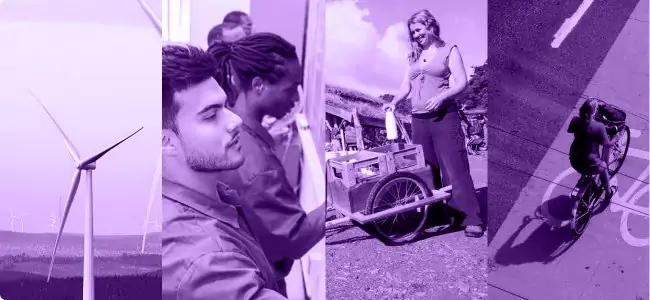Inside The Mud-Walled High-Rise That Cools Itself


Living Paradigms is a series about what we can learn from the customs and cultural practices of others when it comes to solving problems. It is sponsored by Wonderstruck.
It was a hot, sticky September afternoon in New Delhi, the kind of heat that clings to your skin. After navigating congested traffic and rough roads, we reached the city of Faridabad, 60 kilometers from the capital. There, Soumya Jain greeted us in her newly renovated home, a three-bedroom apartment in a high-rise tower block.
Her home might look ordinary from the outside, but it is quietly extraordinary inside thanks to its walls, which are coated with mud plaster instead of cement — an ancient technique reimagined for modern living to keep spaces naturally cool without air-conditioning.
Stepping inside, the change was instant. The heavy afternoon heat seemed to dissipate as cooler, lighter air enveloped us. In the living room, mud-plastered walls gave off a faint, earthy scent reminiscent of rain-soaked soil. Their soft, matte finish absorbed the harsh glare, transforming sunlight into something gentle and diffused.
In the middle of a concrete tower block, Jain has carved out a subtle revolution. Her apartment challenges the assumption that eco-friendly living belongs only to villages or luxury retreats. Instead, it shows how practices passed down the centuries can find urgent new expression in the most unlikely places: A middle-class high-rise on the edge of Delhi.
Jain’s inspiration came from Van Bhoj, a mud-house in Faridabad that was built in the 1990s on the site of a former stone quarry using traditional techniques to unite mud plaster, sal wood, bamboo and lime. Designed by sustainable architecture pioneers Vasanth and Revathi Kamath, it remains 18°F to 27°F cooler than outside temperatures.
Now curated by Ecoplore, a climate-conscious travel company preserving the Kamaths’ vision for urban homes, Van Bhoj has become a popular destination for those wanting to understand more about sustainable design.
Ayushi Saxena, a Delhi-based independent architect specializing in sustainable construction, notes that Delhi’s historic forts and palaces — built centuries ago with natural materials — still stand tall, proving these methods’ durability. “Using locally sourced materials, and designs optimizing airflow and sunlight, such approaches are feasible even in high-density urban apartments,” she says.
Weighed down by negative news?
Our smart, bright, weekly newsletter is the uplift you’ve been looking for.Saxena highlights the benefits of reducing dependence on environmentally-damaging, cement-heavy construction.
“What really sets natural construction apart is how light it is on the planet,” she says. “Cement and steel-heavy buildings trap heat and pump out emissions, but mud, bamboo and stone breathe. They stay cool, adapt to their surroundings and go back to the earth when their time is done.”
Even armed with the facts, Jain faced mixed reactions from her family, who were wary of stepping away from conventional comforts. Her mother was supportive, but her father and sister were skeptical. “Mud walls will make the house look dark and black, that’s not the home I want,” her sister protested. Her father was firmer: “This is not development. After working so hard for a modern home, how can you take me back to my grandparents’ houses?”
Jain explained rising temperatures, heat waves and energy savings, and eventually persuaded the family to visit Van Bhoj.
Today, the Jains live in a flat that stays about nine degrees cooler than the outside heat. “We used to run two ACs regularly, but now the apartment is comfortable with just one, and only occasionally,” says Ranjina Jain, Soumya’s mother. “Earlier, we kept the bedroom AC on all night. Now we switch it on for a short while in the evening, and it stays cool till morning. That’s the real change we have seen.”
The shift doesn’t just save money, it cuts electricity use and lowers the household’s carbon footprint, showing how small design choices can help mitigate climate change.
The Jains transformation took a number of months to complete. For Ecoplore, the journey took nearly five years of research and experimentation before they committed fully to sustainable construction. Founder Prasad says one project in particular became a turning point: The Gandhi Smriti museum, which is located on the site where Mahatma Gandhi once lived and where he was assassinated.
The museum was built in 2005 by Revathi Kamath using natural materials. But after her death, another firm covered the walls with cement and synthetic paints, erasing the organic feel of the space.
“When we were asked to redo parts of [the Gandhi Smriti], we went back to mud. The change was striking,” says Prasad. “The place breathed again, in harmony with Gandhi ji’s ethos. That gave us confidence that these methods can transform even the most iconic spaces.”


Wait, you're not a member yet?
Join the Reasons to be Cheerful community by supporting our nonprofit publication and giving what you can.
Join Cancel anytimeWhen Ecoplore launched its construction wing this year, the response was immediate. “We got over 1,000 queries within months, not just from all over India but from Sri Lanka, Egypt, South America, the Middle East and even Europe,” Prasad says.
“It was unbelievable. Many of these inquiries came from developers and homeowners interested in applying natural construction techniques to high-rises and urban projects, not just rural or eco-resort settings. We have shortlisted projects in Delhi NCR, Bangalore, Odisha and Mumbai to start with.”
This global interest reflects exactly what Jain discovered in her own home: That sustainable living has moved from niche experiment to mainstream necessity. Jain’s apartment, once just a vision, is now part of a growing urban movement of middle-class high-rises adopting time-tested, low-energy construction methods. With each mud wall and bamboo beam, these homes remind us that sustainability, comfort and beauty can coexist, and that small choices inside our living spaces can ripple outward, shaping healthier, cooler, more resilient cities for the future.
Scrolling photos courtesy of Safina Nabi.






Please be good and do not spam. Thank you.